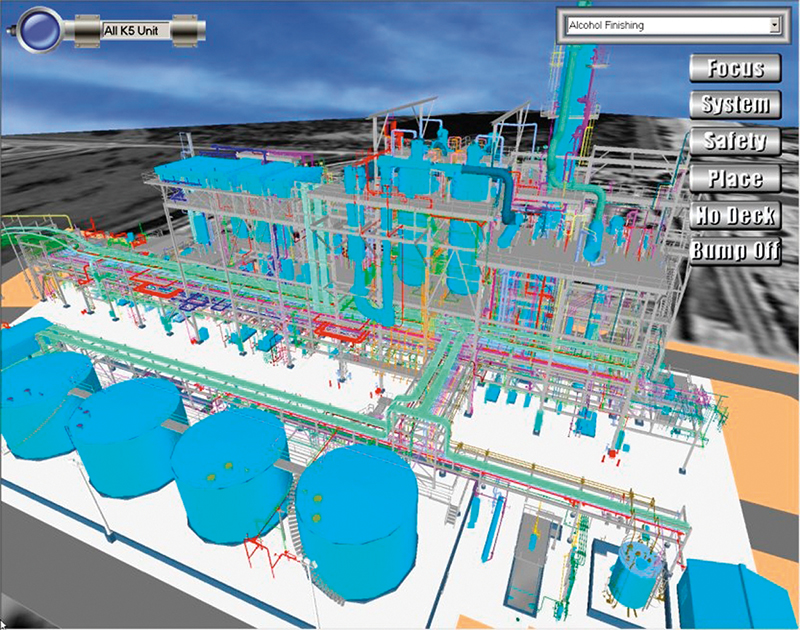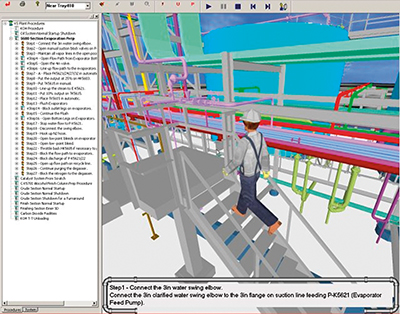
Virtually Out of This World!
Virtual reality is much more than advanced entertainment for video game enthusiaststhe technology is proving its value both on Earth and in space. NASA-developed virtual reality software designed to explore Mars is now helping to build complex facilities before even breaking ground.
NASA's Ames Research Center developed the Mars Map software to guide scientists through the 1997 Mars Pathfinder mission by creating a three-dimensional landscape of the planet. With a map of Mars' surface, NASA mission controllers planned and executed their mission using the model as a point of access and control. The information from Mars Map allowed scientists and operations personnel to command and control remote robotic spacecraft within a virtual environment. The software proved to be critical to the mission's success, since virtual models of Mars' contours and geography were needed to effectively deploy the Mars Rover.
Just as the Pathfinder mission benefited from the Mars Map software, the same technology now aids owners and operators of large, complex industrial facilities who need an intelligent model of their facilities to integrate with their other systems for planning and executing their missions. Therefore, Ames granted Reality Capture Technologies (RCT), Inc., of San Jose, California, a license to further develop the software platform, bringing the technology back to Earth. RCT provides enterprise software to streamline the efficiency and effectiveness of industrial facilities, speed startup time to production, reduce life-cycle costs, and help create a safer working environment. The company incorporated NASA's innovation into software that uses the Virtual Plant Model (VPM)TM to structure, modify, and implement the construction sites of industrial facilities, as well as develop, validate, and train operators on procedures.
The VPM orchestrates the exchange of information between engineering, production, and business transaction systems. This enables users to simulate, control, and optimize work processes while increasing the reliability of critical business decisions. Engineers can complete the construction process and test various aspects of it in virtual reality before building the actual structure. With virtual access to and simulation of the construction site, project personnel can manage, access control, and respond to changes on complex constructions more effectively. Engineers can also create operating procedures, training, and documentation.
Just as NASA used Mars Map to navigate the Red Planet, facility operators can use the VPM to learn how to better "pilot" the sophisticated and expensive industrial plant. According to RCT chief executive officer Ted Blackmon, "What makes this software even more unique is how simple it is. It is almost like a video game where you hold a joystick and walk around making sure everything is working right." In fact, the company's promise to operators and construction foremen is, "If you can play an arcade game, you can use our technology."
Within the VPM, RCT's ConstructSim™ product provides the simulation and optimization of construction sequences to drive the scheduling process and automate the production of work packages. Benefits include data access to those who need it when they need it; improved business decisions using a real-time model and construction schedule of the production plant; leveraged and maximized existing investments in information technology; and a significantly lowered cost of systems integration and maintenance. Moreover, ConstructSim automatically and dynamically produces optimized work packages that reduce construction time and cost.
Another RCT product, OpSim,™ works with the VPM by making the real-time simulation of a plant's start-up, shut-down, operating, and maintenance procedures readily available to plant operators. Similar to pilot training on flight simulators, the technology enables plant operators to acquire the necessary training in a virtual environment. Some benefits of OpSim are improved operator safety, a well-trained workforce, improved plant productivity, faster plant start-up, and reduced costs in procedure development.
RCT clients include Shell Chemicals USA, Rohm and Haas Texas, Inc., and the National Institute of Standards (NIST). Shell has signed an agreement to implement Version 2.0 of OpSim at a new process plant currently under construction in Louisiana. Shell will use the tool to create, maintain, and validate operating procedures. The company can also import existing written procedures contained in text documents through an automated process. Operators will be able to interact with plant components, equipment, structures, and systems using the simple joystick interface, commencing training in a virtual environment months before the plant is fully built.
Virtual Plant Model,™ ConstructSim,™ and OpSim™ are trademarks of Reality Capture Technologies, Inc.

OpSim™ enables operators to interact with plant components, equipment, structures, and systems using a joystick interface. As a result, training can begin in a virtual environment months before a plant is fully built.

Using RCT’s products, engineers can complete the construction process and test various aspects of it in virtual reality before building the actual structure.













